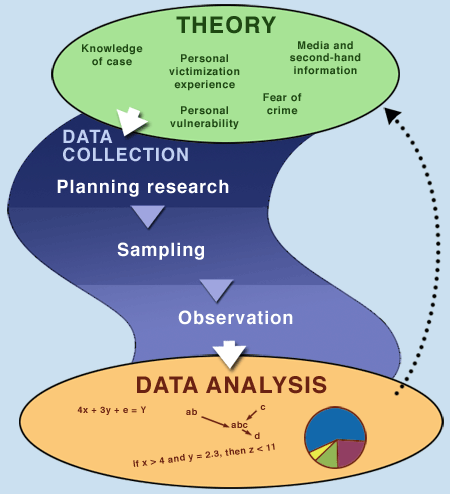Main Content
Lesson 2: Theory and Criminal Justice Research
- First Page
- Previous Page
- 5
- 6
- 7
- Next Page
- Last Page
Foundations of the Scientific Enterprise
The foundations for the study of human behavior have been in place for as long as researchers have cast an eye toward the social world. First and foremost, the enterprise is logico-empirical, meaning that it is based upon logic or rationality and scientific observation. As we've previously explored, theory is the basis for developing testable relationships that are based on logical, explorable line of thought. As such theory does not address 'what should be or what ought to be,' rather the theory states 'what is,' in an objective manner. Remember -- science cannot address value judgments, as values are not rational and therefore scientifically defined as illogical.

The three Foundations of the Scientific Enterprise are as follows:
- Theory
- Data Collection
- Data Analysis
These three are analogous to the components of the Traditional Model of Science, as research methods encapsulate both hypothesis building and observation. But what the 'Foundations' do is put forth explicitly what must be involved for information to be considered scientifically valid. All of the steps within the scientific process are conducted with adherence to these Foundations in mind -- any deviations or missteps harm the validity of the final product. We will be covering those steps in the scientific process throughout the course.
Social Regularity
But there is also one "unofficial"foundation that must be discussed at this time, before we get more into the particulars of social scientific research design illustrated in Figure 2.2. What is referred to here is the idea of social regularity, the notion that the social world has some pattern and regularity to it -- that not all human behavior is chaotic or random.
In order for us to study behavior in a scientific fashion, this idea must be assumed to be fact. You'll remember that we said that social scientists look to establish patterns and trends among groups of people, but in the end behavior is ultimately the free choice of the individual (a person's "free will"). For example, if you are to be at work at 8:00, Monday through Friday, the pattern is that you'll arrive at work those days sometime around 8:00. But there may be a day when you aren't at work, for whatever reason. One of those reasons may simply be you've chosen to take a day off. Social Science cannot 'predict' these seemingly random choices that people make, therefore our discipline has come under attack from the so-called hard sciences (such as chemistry, physics, and biology) because we don't have absolutes, and therefore there is no way of knowing if our conclusions are truly valid. In the end, we've settled for not being able to produce absolutes, and to rely on illustrating patterns of behavior in a probabilistic sense. For example, we say students attend class 80 percent of the time. This illustrates the behavior, but doesn't define it as absolute or without variation.
And as a final note on this: while trends and patterns of aggregate (group) behavior can aid in predicting individual behavior, any conclusions about individual behavior based on aggregate patterns should be viewed with extreme caution. There is a far greater chance of being wrong when predicting an individual's behavior because the"free-will factor" is so much greater than within a group, and more difficult to account for.
In the second section of the course, i.e. structuring criminal justice inquiry, we will examine how scientists use social regularity to frame their research in a deterministic sense.
- First Page
- Previous Page
- 5
- 6
- 7
- Next Page
- Last Page
